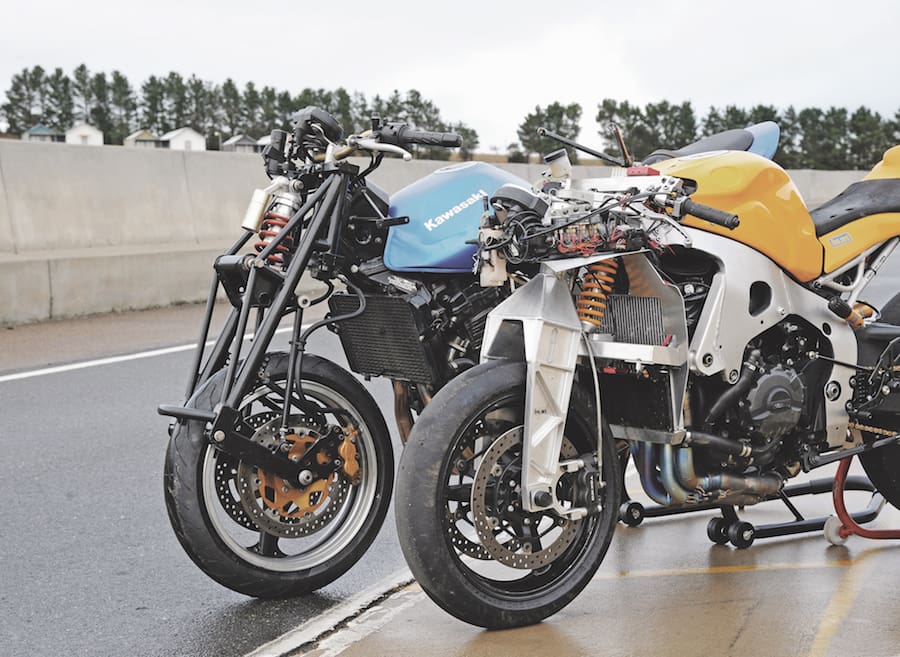Since Gottlieb Daimler and Wilhelm Maybach produced what is claimed to be the first motorcycle in 1884, the design has come a long long way. That first frame was made of wood – as was everything except the engine – and the layout revolved around a beam frame attached to a steering head, with a standard solid fork (in this case bits of wood) holding the front wheel and allowing steering as on a modern bike. A top speed of just 11km/h with a tail wind meant handling wasn’t really a worry, and as for comfort, well, Gottleib and Wilhelm were just happy the thing moved at all.
Australia has its own inventors, and its own innovations. Like Daimler and Maybach, Alan King and Laurie Smith have a shared passion, even though they hadn’t met until the day of our test. Their mission: to prove that the front fork as we know it isn’t the be-all or end-all.
Laurie (The Black) Smith
2010 CBR1000
Laurie decided to take on the racetrack with his design, grafting its unique features onto the front of his CBR1000. Alan, on the other hand, is out to prove that his invention will provide a smoother more stable ride on real-world roads. He started 14 years ago with a GSX550 Suzuki, then, when that proved too slow, he upgraded to a faster but still mellow 2006 Z1000 Kawasaki.
Two paths – one dream. We rode the bikes at Wakefield Park Raceway to see if either design can steer us towards a better future.
When I first saw Laurie’s CBR I was pretty excited. Apart from the fact that it was a racebike set up on slicks, it had the trickest looking nonconventional front end I have seen fitted to a motorcycle. The workmanship that has gone into developing that system is substantial, with a rumoured $30,000 thrown at the project since it began in 2004.
Laurie’s approach is loosely based around the Hossack design, which has been drafted in for many projects over the years. But what makes his design different is its ability to absorb bumps on a full lean angle. If you look closely, hidden behind the lower arm is a set of Cane Creek mountain bike shocks sitting parallel to the ground. These are attached to the main upright on the outside and to the heart of the structure at the lateral mid-pivot, and allow controlled movement by 25mm left or right from the centre line when the bike is leant over, offering lateral mechanical suspension for possibly the first time on a motorcycle.
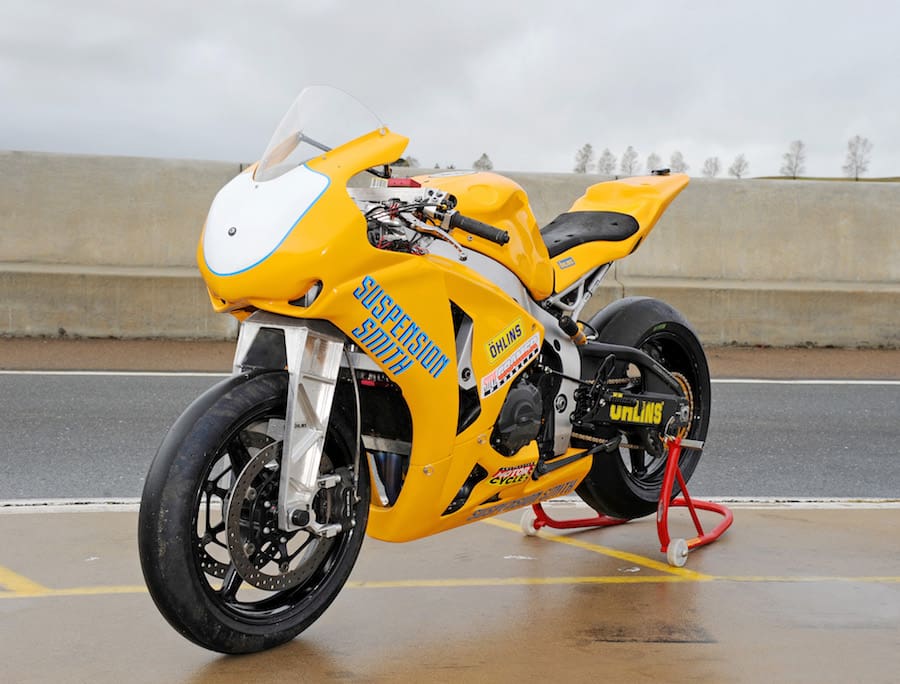
Now obviously under brakes you can’t have the front wheel weaving from left to right by 50mm, so there is an electronic catch. An electro magnet is tucked up underneath the lateral mid-pivot, and when charged with 24 volts it has a holding ability of 100kg, keeping the front end steady and in line.
It’s activated by a trigger connected to the front brake lever, ensuring braking stability. When entering a corner, the rider can hit a button with his or her thumb on the left switchblock, deactivating the magnet and letting the extra shocks do their magic. In the future Laurie hopes to use one of the new inertial measurement units fitted to many bikes nowadays to calculate the lean angle of the bike, thus making the system fully automatic. According to him, it would be a world first.
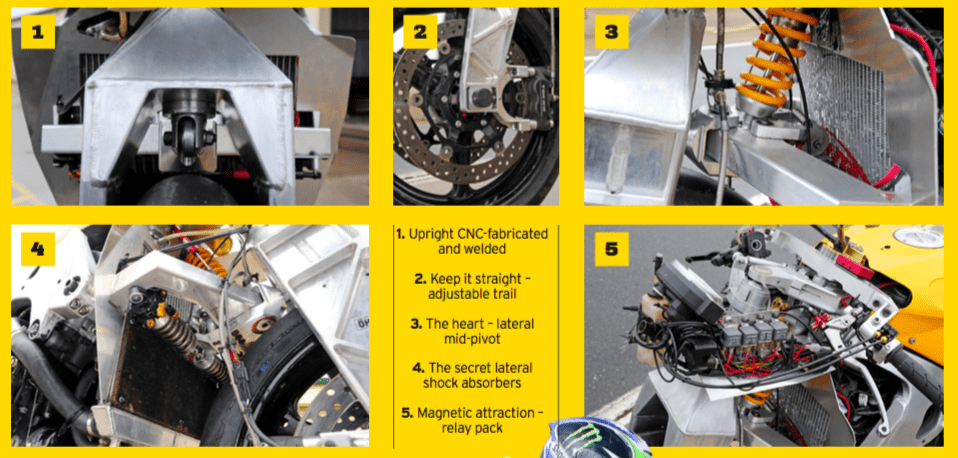
The Ride
From the outset, Laurie’s bike feels like the racebike it is – taught and sharp handling. It’s got a much steeper steering angle than traditional design, with around the 18o mark chosen (23.5o average). After a few familiarisation laps, I started to put my head down and build trust in the workings of the front end. At first I held off using the magic button for lateral suspension because I wanted to give myself a base on which to judge the lateral impact later.
Initially the action of the front end was surprisingly good with the vertical Öhlins front unit set well for the track. But as I pushed harder I found it more difficult to trust the steep steering angle as mentally it felt like it wanted to fall and tuck; I wasn’t willing to commit to carry the speed and angle into the corner. Apart from this one negative, the ride was generally good, boding well for the design.
Ideally, I would have liked to try the bike with a more conventional angle as I think it’s the key to inspiring confidence in a rider who jumps on the bike for the first time. The part that really intrigued me though was the lateral suspension action.
Later in the day I hit the button as instructed entering the corners to turn the electro magnets off and let the lateral shocks work. There was movement of a very subtle nature and it didn’t hinder me in any way, so this is a good sign. It’s sort of an ‘is it or isn’t it’ feeling that goes through your head, and the idea is definitely worth investigating more.
Wakefield is a tight and bumpy track where anything other than a perfect set-up can give the rider problems, and I found that although the front angle wasn’t to my liking, it was no different to riding a bike with a conventional fork set at a steep angle. Laurie’s front end is in the development stage, and although it’s not perfect yet, there is massive scope to improve it. Will it be better than a factory MotoGP telescopic fork? I hope one day we get to find out.

Alan (The Road) King
Z1000 Kawasaki
Alan has taken a very different approach in implementing his front-end design. Along with good friend and fabricator Peter Selke, he has spent a lot of time in the garage bending, grinding and welding over the past 14 years, hence the use of strong chrome-moly material rather than aluminium for construction. Keeping costs down and ease of working were also high priorities, especially while they are still tinkering and making improvements.
Alan started looking at alternative front ends in the 80s, but it wasn’t until 2003 that he was armed and ready to attack the project. He chose the trailing arm system because in his opinion it had the best chance of success over other telescopic forks which were often heavier, restricted steering lock, or didn’t separate braking force from suspension action. He realised trailing arm systems, mainly fitted to scooters, weren’t perfect either, with minimal suspension travel. The short arms also caused a dramatic change in wheelbase over the course of their action. The other drawback was the mounting of calipers to the trailing arms, which affected front-end dive.

Alan’s system is unique in the way it addresses the failings of the standard trailing-arm system and corrects its weaknesses.
He fitted a lengthier trailing arm that increases travel (120mm) and reduces the wheelbase change over that travel, giving the front end more stable geometry. The longer arm increased the chance of twisting, so it needed to be activated as close to the wheel as possible by a couple of vertical tie rods via a linkage-style cushion-arm system. This also triangulated the front end, giving the strength needed to keep it all in line.
The next step was to minimise the change in steering inertia over full suspension travel, as any significant change can result in bump steer. Although not considered a problem with telescopic front ends, it can happen with most alternative front ends.
A considerable amount of time was spent optimising the design to achieve minimum change in inertia over full suspension travel. This also resulted in the use of torque rods to connect the brake calipers to the fork rather than using the scooter method. Alan’s system allows for an adjustable mechanical anti-dive option by altering the fixing points of the brake torque rod, completely independent of suspension actuation.
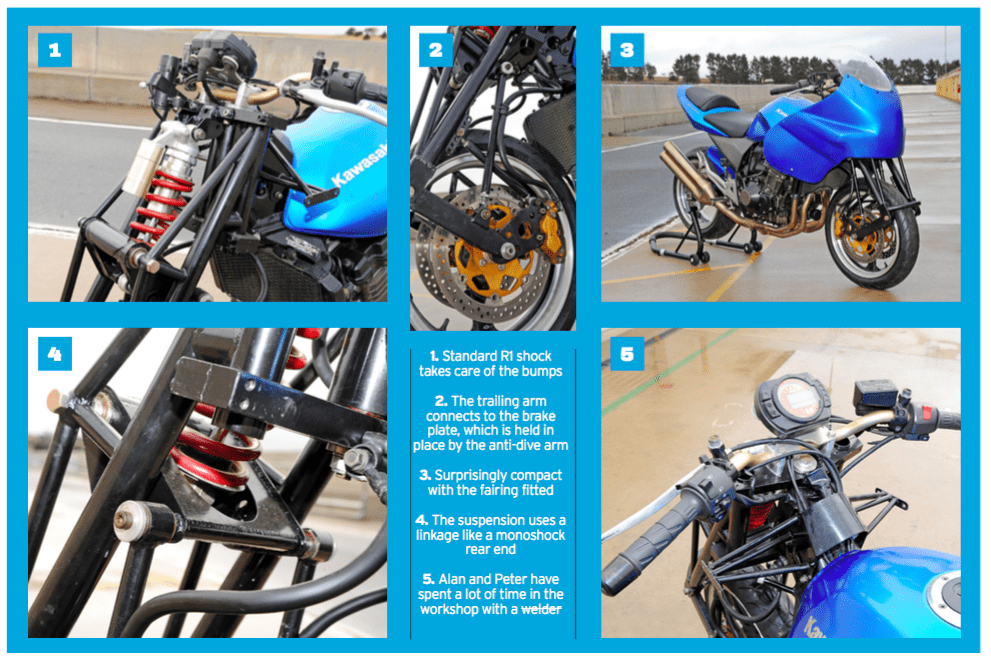
The Ride
Alan’s goals are completely different to Laurie’s, so taking the Kawasaki onto the track required a different mindset. As I headed down pitlane the first thing that struck me was the normality of this bike. It felt as though I was on a standard machine, with no quirkiness and no feeling of bulk.
That was until I tipped in to the first corner and noticed how light the steering was. No effort at all is needed to get Alan’s design pointed where you want it to go – ideal for the cruiser, tourer and roadbike market that his idea is aimed at. It also coped with the bumpy nature of the circuit incredibly well, as that trail-arm front end soaked up all the harshness I was feeling on the race-oriented CBR. The standard 2003 R1 rear shock purchased from a wrecker was doing an amazing job in its second life at controlling the movement and wheel force the Z1000 chassis fed into it.
Leaning the bike over on the track it kept that feeling of normality, but the Z1000’s age and softness prevented testing at any serious lean angles or limits. Don’t get me wrong, although it’s no racebike, in the end we were circulating less than seven seconds off the time I achieved on the CBR.
One aspects I wanted to test was the manually adjustable anti-dive. I asked Alan to set the front up to give me full dive, and the bike reacted very much like one with a telescopic front end. I then pulled in and we set it up with full anti-dive properties. Magically, no dive. It’s nice to know that aspect worked, as it means the customer can dial in the feeling he or she wants.
I think Alan is on the right track in his initial design for a viable road-going alternative to the telescopic fork.

Which fork to take?
After a mind-boggling day of front-end craziness, I came away very impressed with both designs. Although they aren’t there yet, both show promise and I hope Alan and Laurie get the chance to develop that and unleash their designs onto the world stage proper. It’s amazing how much time and effort these two guys have put into their respective projects, and one can’t help but feel that it almost consumes them. They both have a deep passion and will stop at nothing to make their systems work. In a telescopic world, it’s refreshing to see these new ideas being showcased, and even more impressive is the devotion of men like Laurie and Alan.
Alan’s system
Z1000 (2006)
1. Original steering head replaced with new welded chrome-moly steel head with steeper head angle and main frame extended to new head to suit. Wheelbase basically maintained as standard.
2. Triple clamps replaced with new billet aluminium triple clamps.
3. Front suspension uses a single 2003 Yamaha YZF-R1 rear spring/shock with stiffer spring fitted. New front suspension travel is 120mm, the same as the Z1000’s original fork.
4. Original front wheel, brakes, handlebars, levers retained. Brake lines replaced. New brake caliper holding plates fabricated. All other parts of the bike are standard Z1000.
5. Upper fairing fitted to conceal most of suspension design. ZZR600 fairing used and modified to suit new suspension.
6. Adjustable trail and braking (anti-dive) were included on the prototype to determine reasonable base settings.
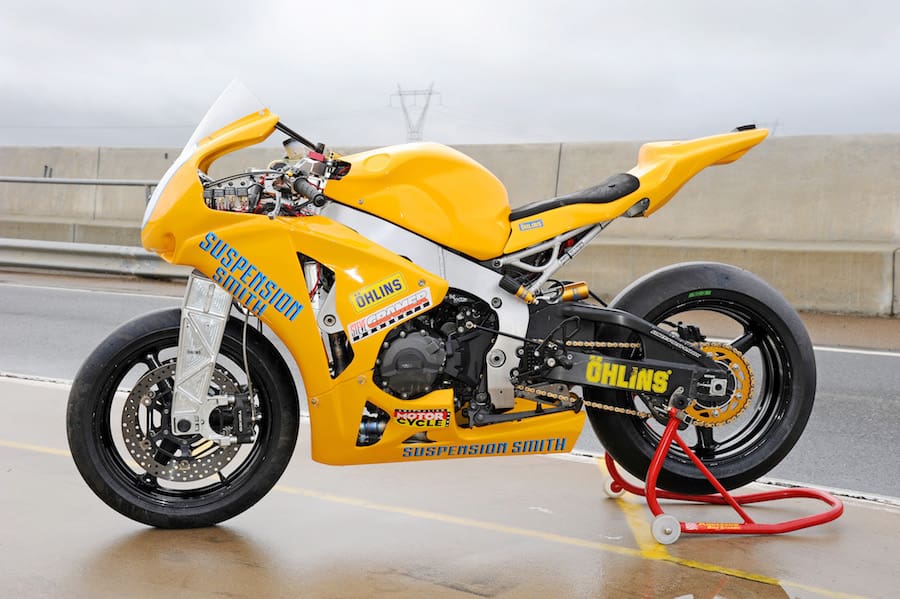
Design notes
1. Low unsprung weight compared to most alternative front suspensions.
2. Minimal change in steering assembly inertia over full suspension travel – thus minimising bump steer which affects alternative suspension designs.
3. Braking is independent of suspension – thus no fork stiction issues as with telescopic forks.
4. More compliant suspension over bumps compared to teles due to low friction roller and ball bearings.
5. Softer spring used than with teles, thus a more compliant ride.
6. Reduced (about 25 per cent) wheelbase change over full suspension travel compared to teles and thus reduced weight transfer to front tyre under brakes. Minimal change in wheelbase over second half of suspension compression e.g. when cornering hard and hitting a bump.
7. Reduced change in trail when braking compared to teles, improving straight line stability when braking, particularly over bumps. Little reduction in trail over first half of suspension compression. Reduction in trail over full suspension travel when braking is about 20 per cent – compared to 36 per cent for a typical tele sportsbike.
8. Reduced rake angle, reduced change in trail and in wheelbase over suspension travel should result in safer cornering and braking in wet and dry.
9. Reduced change in trail compared to teles when hitting large bumps when not braking.
10. May give safer braking when cornering as trail stays fairly constant over suspension travel
when braking.
11. Fork is rigidly supported (cross-braced and triangulated) over the full length compared with inverted teles which have no cross-bracing below the triple clamps.
12. Single spring damper unit instead of two with teles. Eliminates interference forces between two springs/dampers and is easier to remotely control e.g. to adjust preload and damping.
Laurie’s system
CBR1000 (2010)
1. Careful setting up and measuring of the stock Honda bike to allow the Hossack lateral suspension to be designed into it with the correct alignment and geometry, and with minimum modification to surrounding bike components.
2. Cutting away of stock Honda steering head.
3. Fabricating a welding jig to locate and fix the new pivot points and mounts for the Hossack suspension and steering for welding to the Honda frame.
4. Fabrication and machining of the Hossack lateral suspension components from 6061 T6 aluminium.
5. Modification of a TTX30 Öhlins shock to suit the application.
6. Fabrication of a custom radiator to suit the design.
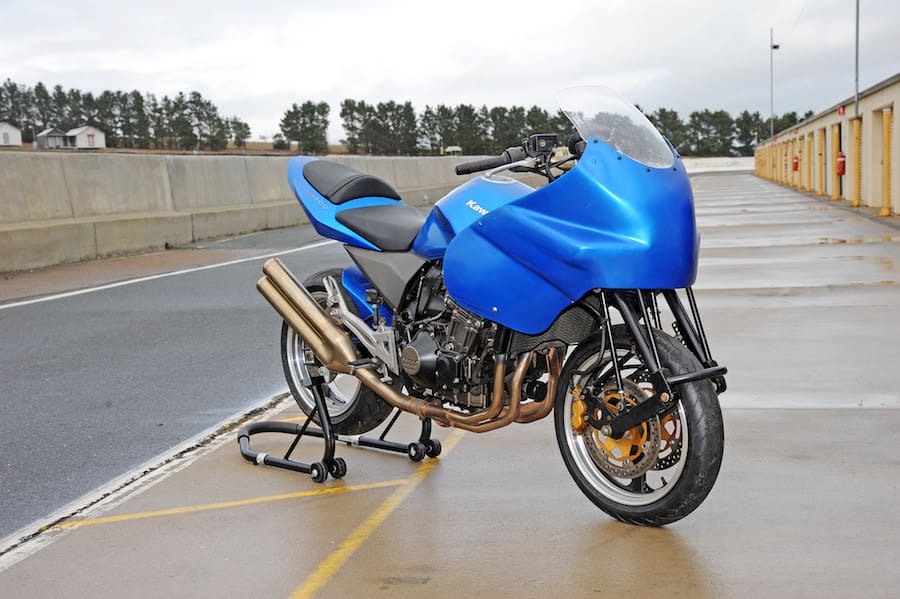
Design notes
1. The main aim of this prototype was to experiment with the introduction of a laterally deflecting suspension system to investigate a bike’s behaviour and possible performance advantages.
2. The Hossack suspension was found to be the best method of introducing such a lateral suspension system with the least complexity and minimum compromise to layout and performance.
3. Fits within the normal architecture of today’s bikes.
4. Good strength/stiffness to weight ratio.
5. Very low steering inertia.
6. Multi-adjustability of steering geometry, suspension, geometry, anti-dive/pro-dive characteristics.
7. Low stiction and friction in moving/pivoting parts for ideal suspension response and feel.
8. A more direct steering and feel relationship comparable to a telescopic fork.
9. Minimal bump steer in the steering linkage geometry.
10.Lateral suspension system gives a degree of compliance and control at very high lean angles, unlike normal suspension.
11. Lateral suspension system introduces a degree of lateral compliance and a source of lateral damping which may help in recovery from major/minor instances of instability, much like a steering damper.
12. Lateral deflection in the front wheel when steering which may help with counter-steer sensitivity, resulting in faster rates of roll and changes of direction.
